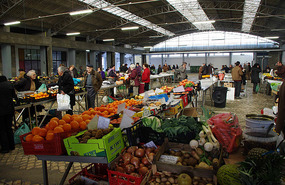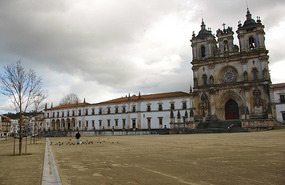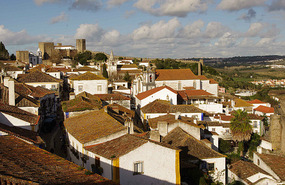We woke up to a beautiful day so headed down to the beachfront in Nazaré for a look around. We arrived in town and the streets were covered in sand. I guess the storm had blown it off the beach because it was everywhere. There were some people shovelling out the kids playground and you could barely see the small fence around it. The sand was piled in the streets from where they had already cleaned.
We parked on the beachfront and hopped out to go for a short walk. We saw a lady laying out some fish to dry on racks. She was the only one working today since most of the other racks had been blown away in the storm and the men were still trying to find them, clean them up or repair them as needed. The waves were still quite amazing considering it wasn't terribly windy and we had fun watching them pound onto the beach. We walked along for a ways towards the breakwater and were amazed at how high the spray from the waves went when they crashed.
Next we went to the town of Alcobaça which is known for its monastery. Before visiting the monastery we decided to check out the market which our guidebook said was best on Mondays. At the entrance there were people selling fruit. Since our supply had dwindled, we decided to pick up a few more things and wandered along browsing. Eventually we stopped at one stand and I pointed to the pears and showed 6 fingers, not knowing how to say 6 or pears in Portuguese. The lady filled in for me and then we moved on to apples… I wanted to know if she had any crunchy ones, but was definitely not going to be able to ask that! Instead I asked if she spoke English (no) and then French (yes).
So I asked for some not soft apples since she didn’t know the word crunchy. We picked up four of them and then 10 clementines. The grand total was €1.79! The oranges were delicious and easily beat out anything we can get at home. We then looked around at the rest of the market. There was salt cod from the region displayed on huge tables. We also saw live chickens, rabbits and guinea pigs for sale – a definite first for us! The next room over had a few bakers and we picked up a bread and treat for later. We wandered the veg stands as well but didn’t need anything at that particular time (also there seems to be a lot of cabbage for sale and we couldn’t imagine fitting one of those in our fridge!). We then headed back to the van to drop off our purchases and then head over to the monastery.
Construction started on the monastery in 1178 and the first monks arrived in 1228. The church is the largest in Portugal and was of a much simpler design that the one in Batalha. At the front of the church, on either side are two tombs. They are the tombs of Dom Pedro (King Peter I) and Dona Inês de Castro who were in love. Unluckily for them, Pedro’s father was concerned about Spanish influence and had Inês murdered. The tombs are feet-to-feet in each transept so that when the angels wake them on Judgement day, the first thing they will see is each other. The tombs were quite ornately carved and except for some damage by Napoleon’s troops, are in quite good shape.
The Hall of Kings statues of most of Portugal’s kings up to 1755. They even had a wider pedestal installed in anticipation of the first queen and her big dress, but after the earthquake there was no more money for statues. The cloisters were quite ornate and we enjoyed looking at all the details on the pillars. There were also orange trees in the middle which are rather fascinating since we’ve never seen oranges or lemons growing before! It is very tempting to just reach up and pick one from all the trees we’ve passed by, but so far we’ve resisted. We visited the refectory which is where the monks ate and Anoop climbed up to the "Reader’s Pulpit" where a monk would read while the others ate. The kitchen next door was incredible. The thee-part oven could roast 7 oxen simultaneously! It really was enormous. They could feed up to 999 monks and the peasants who worked on the church-owned land. We finished our visit from the second level of the cloisters with views into the courtyard below.
We then headed over to the walled town of Óbidos which had a neat 16th century aqueduct and a 14th century wall. The houses were all whitewashed and the yellow and blue trims were traditionally used to mark out property lines. We passed by a pillory which was used to tie miscreants to in order to receive whatever punishment was deemed appropriate. We visited a small church which had a painted wood ceiling.
Then we continued on down the lane to the castle at the end. It has since been converted into a fancy hotel, but there were great views from the terrace below. We then headed back to the entrance of town and headed up on to the ramparts. They were quite slippery so we only went on the wider part for a view. You could walk the whole way around, but they were quite sloped and had no guide rails. We decided it was perhaps better in the summer when it hadn’t just been raining and growing moss on the cobbles! Óbidos was a cute town and we were glad we had stopped by on our way to Lisbon.
We managed to circumnavigate Lisbon and not go through the mess of its downtown autoroutes. We decided the detour around was worth the €2.40 in autoroute fees, just to avoid the confusion. We eventually found our way to camp after a pre-mature exit from the highway and settled in for the next few nights.
Nazaré, Alcobaça & Óbidos
Monday, January 21, 2013
 Alcobaca, Estremadura, Portugal
Alcobaca, Estremadura, Portugal
Other Entries
-
68Planes, Trains and Automobiles
Nov 1468 days prior Mulhouse, Francephoto_camera34videocam 0comment 6
Mulhouse, Francephoto_camera34videocam 0comment 6 -
69Beaune
Nov 1567 days prior Beaune, Francephoto_camera60videocam 0comment 7
Beaune, Francephoto_camera60videocam 0comment 7 -
70Royan
Nov 1963 days prior Royan, Francephoto_camera9videocam 0comment 4
Royan, Francephoto_camera9videocam 0comment 4 -
71A second visit to London
Nov 2557 days prior London, United Kingdomphoto_camera93videocam 0comment 15
London, United Kingdomphoto_camera93videocam 0comment 15 -
72En route to Bangalore
Nov 2656 days prior Dubai, United Arab Emiratesphoto_camera10videocam 0comment 3
Dubai, United Arab Emiratesphoto_camera10videocam 0comment 3 -
73Bangalore
Dec 1636 days prior Bangalore, Indiaphoto_camera134videocam 0comment 17
Bangalore, Indiaphoto_camera134videocam 0comment 17 -
74London, our third and final visit?
Dec 1933 days prior London, United Kingdomphoto_camera32videocam 1comment 2
London, United Kingdomphoto_camera32videocam 1comment 2 -
75Visiting friends in Scotland
Jan 0417 days prior Beith, United Kingdomphoto_camera68videocam 0comment 4
Beith, United Kingdomphoto_camera68videocam 0comment 4 -
76Preparing for new adventures
Jan 0813 days prior Royan, Francephoto_camera3videocam 0comment 0
Royan, Francephoto_camera3videocam 0comment 0 -
77Citadel in Blaye & Dune de Pilat
Jan 1011 days prior Blaye, Francephoto_camera13videocam 0comment 0
Blaye, Francephoto_camera13videocam 0comment 0 -
78Minh-Yen arrives!
Jan 1110 days prior Zarautz, Spain and Canary Islandsphoto_camera7videocam 0comment 0
Zarautz, Spain and Canary Islandsphoto_camera7videocam 0comment 0 -
79Tapas in San Sebastian
Jan 129 days prior San Sebastián - Donostia, Spain and Canary Islandsphoto_camera37videocam 0comment 6
San Sebastián - Donostia, Spain and Canary Islandsphoto_camera37videocam 0comment 6 -
80Biarritz
Jan 147 days prior Biarritz, Francephoto_camera27videocam 0comment 2
Biarritz, Francephoto_camera27videocam 0comment 2 -
81St. Jean de Luz
Jan 156 days prior Saint-Jean-de-Luz, Francephoto_camera19videocam 0comment 4
Saint-Jean-de-Luz, Francephoto_camera19videocam 0comment 4 -
82An unforgettable lunch in Bilbao
Jan 165 days prior Bilbao, Spain and Canary Islandsphoto_camera28videocam 0comment 1
Bilbao, Spain and Canary Islandsphoto_camera28videocam 0comment 1 -
83Sipping Port in Porto
Jan 192 days prior Porto, Portugalphoto_camera64videocam 0comment 2
Porto, Portugalphoto_camera64videocam 0comment 2 -
84Batalha Monastery
Jan 201 day prior Batalha, Portugalphoto_camera18videocam 0comment 0
Batalha, Portugalphoto_camera18videocam 0comment 0 -
85Nazaré, Alcobaça & Óbidos
Jan 21 Alcobaca, Portugalphoto_camera57videocam 1comment 0
Alcobaca, Portugalphoto_camera57videocam 1comment 0 -
86Lisbon
Jan 232 days later Lisbon, Portugalphoto_camera99videocam 0comment 0
Lisbon, Portugalphoto_camera99videocam 0comment 0 -
87Cromlechs, Cork Groves & Roman Ruins
Jan 243 days later Évora, Portugalphoto_camera25videocam 0comment 2
Évora, Portugalphoto_camera25videocam 0comment 2 -
88Boat trip around the Lagos rocks
Jan 265 days later Lagos, Portugalphoto_camera46videocam 1comment 0
Lagos, Portugalphoto_camera46videocam 1comment 0 -
89News Flash:Tourist spotted swimming in the Algarve
Jan 265 days later Lagos, Portugalphoto_camera3videocam 0comment 0
Lagos, Portugalphoto_camera3videocam 0comment 0 -
90Seville
Jan 287 days later Seville, Spain and Canary Islandsphoto_camera70videocam 0comment 0
Seville, Spain and Canary Islandsphoto_camera70videocam 0comment 0 -
91White Hill town of Ronda
Jan 309 days later Ronda, Spain and Canary Islandsphoto_camera39videocam 0comment 1
Ronda, Spain and Canary Islandsphoto_camera39videocam 0comment 1 -
92A Taste of Tangier
Feb 0212 days later Tangier, Moroccophoto_camera49videocam 0comment 3
Tangier, Moroccophoto_camera49videocam 0comment 3 -
93The Rock of Gibraltar
Feb 0313 days later Gibraltar, United Kingdomphoto_camera33videocam 0comment 1
Gibraltar, United Kingdomphoto_camera33videocam 0comment 1 -
94Paella feast in Nerja
Feb 0414 days later Nerja, Spain and Canary Islandsphoto_camera20videocam 0comment 1
Nerja, Spain and Canary Islandsphoto_camera20videocam 0comment 1 -
95The Alhambra in Granada
Feb 0515 days later Granada, Spain and Canary Islandsphoto_camera85videocam 0comment 1
Granada, Spain and Canary Islandsphoto_camera85videocam 0comment 1 -
96Snacking our way through Madrid
Feb 1121 days later Madrid, Spain and Canary Islandsphoto_camera41videocam 0comment 1
Madrid, Spain and Canary Islandsphoto_camera41videocam 0comment 1 -
97El Escorial: A cold grey palace
Feb 1222 days later El Escorial, Spain and Canary Islandsphoto_camera6videocam 0comment 0
El Escorial, Spain and Canary Islandsphoto_camera6videocam 0comment 0 -
98Fascist Church, Aqueduct and Segovian Tasting Tour
Feb 1323 days later Segovia, Spain and Canary Islandsphoto_camera27videocam 0comment 1
Segovia, Spain and Canary Islandsphoto_camera27videocam 0comment 1 -
99Holy Toledo!
Feb 1424 days later Toledo, Spain and Canary Islandsphoto_camera63videocam 0comment 1
Toledo, Spain and Canary Islandsphoto_camera63videocam 0comment 1 -
100Modernisme sights in Barcelona
Feb 1828 days later Barcelona, Spain and Canary Islandsphoto_camera225videocam 1comment 1
Barcelona, Spain and Canary Islandsphoto_camera225videocam 1comment 1 -
101Day trip to Sitges
Feb 1929 days later Sitges, Spain and Canary Islandsphoto_camera11videocam 0comment 0
Sitges, Spain and Canary Islandsphoto_camera11videocam 0comment 0 -
102Cassoulet in Carcassonne
Feb 2636 days later Carcassonne, Francephoto_camera19videocam 0comment 2
Carcassonne, Francephoto_camera19videocam 0comment 2 -
103Albi: Toulouse-Lautrec & amazing cathedral
Feb 2737 days later Albi, Francephoto_camera15videocam 0comment 0
Albi, Francephoto_camera15videocam 0comment 0

 Alcobaca, Estremadura, Portugal
Alcobaca, Estremadura, Portugal































































2025-05-22